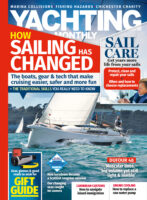Celebrating 100 years of the BBC Shipping Forecast, Jane Russell takes us on a series of coastal cruises through the forecast sea areas, exploring some of the special places on offer in each of them
The Forth sea area runs from just north of Stonehaven on the East Aberdeenshire coast southwards to Holy Island off the Northumberland coast, including the approaches to the River Tay and the outer River Forth itself.
This is a coastline with few offlying islands, but there are some glorious firths and rivers to explore, giving access to historic towns and cities, notably the capital Edinburgh. Prevailing summer winds are westerly, off the land, with a mean wind strength of F3 to 4. Summer gales are rare and rainfall is much lower than on the West Coast.
Fog, or ‘haar’, isn’t usually an issue but happens a bit more in early summer. All of this is a recipe for some very enjoyable cruising.
Easterly winds are relatively infrequent but, when they persist, they expose this coast to swell. In these conditions, passagemaking can become quite unpleasant and many of the smaller harbour entrances become dangerous. Even without easterly winds, if Atlantic swell finds its way over the top of Scotland and down the east coast, similar problems arise. Monitor swell direction and height as well as the wind forecasts.
Tides flood southwards along this coast, generally at around 1.5 knots or less. But the streams run much more strongly in and out of the Tay estuary.
In the Forth estuary, the river narrows under the bridges where wind acceleration can combine to create tricky conditions. The streams also run strongly around Holy Island. The area is busy with commercial shipping and windfarm support. The Forth and Tay Navigation Service VTS is on VHF 71.

Twin headsails sailing on the Firth of Forth. Photo: Peter Russell
Leaving Peterhead
Leaving Peterhead with a westerly F4 we had made good progress, reaching down the coast over flat seas and smoothly crossing into the Forth sea area. About 5 miles north of Stonehaven harbour, the wind started to back and then dropped to a very light and fickle breeze. We tacked in, but eventually had to admit defeat and motor sailed the last couple of miles.
Blue skies were now breaking through the grey, with the monumental war memorial, styled as a ruined Greek temple, conspicuous on the skyline above the town. Stonehaven harbour has featured in winter storm news reels with maelstrom images and tales of severe flooding.
It is certainly not the place to be in any easterly swell. For us though, with the wind in the west and slight seas, it was the perfect place to tarry for a while. There was plenty of depth and space for Tinfish inside the end of the outer breakwater.
Both the 16th Century Tolbooth building on the quay and the 21st Century wood-fired beach sauna, uniquely housed in a converted horse trailer, seemed equally in place here, and we were to be continually charmed by this absolute gem of a harbour.
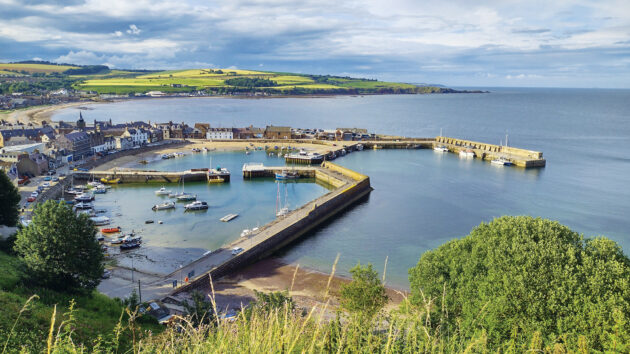
Stonehaven is an absolute gem of a harbour. Photo: Peter Russell
Stonehaven
After a warm welcome in the cheerfully crowded, cosy confines of the harbourmaster’s office, we wandered into town along the boardwalk, with its trail of quirky sculptures, then past the impressive glass-topped river flood defences and round to the old market square.
Here, an information board introduced us to a son of the town. It felt a good measure of the community that it chose to celebrate the ingenuity of robert william thomson, who invented both the refillable fountain pen and the pneumatic tyre.
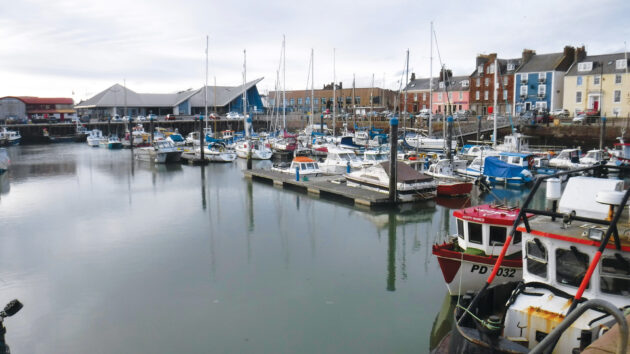
A busy Arbroath Harbour. Photo: Peter Russell
Perhaps no surprise then to discover the public barometer on the town house tower, erected thanks to the historic foresight of the townspeople in wanting their fishermen to be able to anticipate the weather. Possibly less admirable but no less celebrated is the claim of the carron to be the first fish ’n’ chip shop ever to sell a deep-fried mars bar!
All this can-do attitude seems to go back a very long way; dunottar castle, a welcome leg-stretch along the coast, was where the locals outsmarted oliver cromwell in hiding the honours of scotland, the scottish crown jewels.
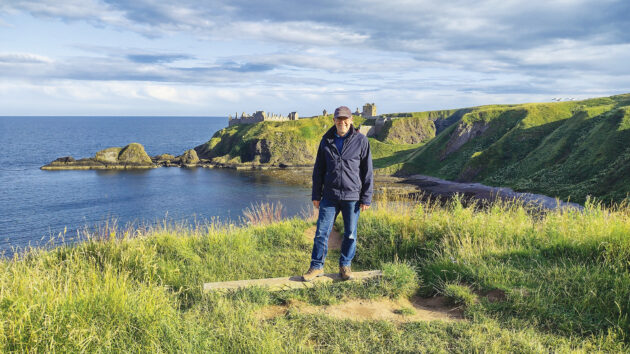
David on the walk to Dunnottar Castle, one-time hiding place of the Honours of Scotland. Photo: Peter Russell
Moving South to the River Tay
Our easy time in Stonehaven felt like a holiday mini-break, but with only three weeks left to complete our round Britain it was time to move on south. We extricated ourselves off the wall from inside a Dutch boat and motored out, giving good clearance to the rocks round Downie Point.
For a couple of miles we poled the jib out in the light NW, but then the wind filled in on the beam from WNW and, once again on this east coast, we were full-sail reaching over a flat sea. There were several rig support ships anchored off Montrose to starboard; to port a passing cetacean which we think was a big bottlenose dolphin.
A stop at Arbroath was really tempting us, but the beam wind was holding for longer than expected so we headed on towards the mouth of the River Tay, catching distant glimpses of the Bell Rock lighthouse out to sea. Briefly regretful as the wind dropped out, we were partially forgiven by a gentle ESE sea breeze which took us to the Tay channel. But we had delayed a bit too long.
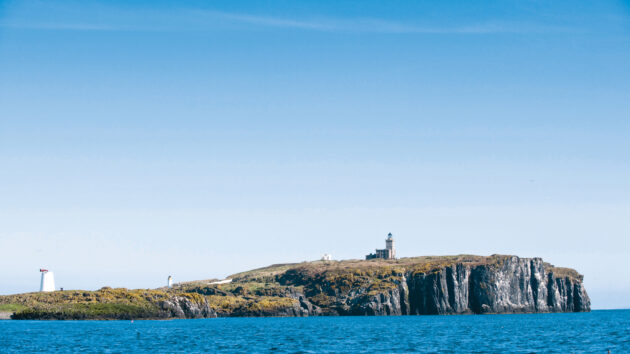
Isle of May in the Firth of Forth. Photo: Peter Russell
As we reached the narrows at Broughty Ferry we could feel the growing strength of the ebb, and by the time we had motored to the visitor moorings off the Royal Tay Yacht Club they were being pulled under by 3 kts of stream. It took a couple of attempts to finesse a controlled ferry glide up to the pick-up.
These moorings feel a bit exposed in the breadth of the Tay, and with wind against tide they can get a bit lumpy, but we had a very warm welcome from the club and we were well entertained by all the dinghy sailing around us, including day courses and evening racing.
None of them were fazed, either by the tide or by the passing tug-towed jack-up rigs, so neither should we be! From the RTYC it’s only a short walk to the bus route into Dundee.
We were very happy to be tourists for the day, particularly along the riverside where you can visit the RRS Discovery, sailed by Robert Falcon Scott to Antarctica in 1901, and the acclaimed V&A Dundee, Scotland’s museum of design. Walkways through the intriguing waterfront gardens led us to the 200-year-old HMS Unicorn in the City Quay development of the dock basins. A marina is promised there in the future.
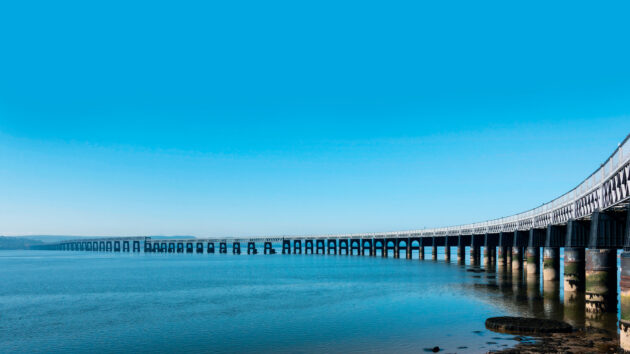
Bridge over the River Tay. Photo: Peter Russell
Approaching the Firth of Forth and Edinburgh
With strong northeasterlies coming later in the forecast, we made full use of the ebb to take us out of the Tay into a gentle easterly breeze. The seas were not yet building, so we cracked off over the end of the shoals and had a good reach across St Andrew’s Bay towards Fife Ness.
Approaching the Firth of Forth, we left the Isle of May to port and, with the flood under us and the easterly building behind us, we ran in along the side of the South Channel to Granton near Edinburgh. Granton was one of those places where it proved difficult to pin down exactly what the depths would really be on the visitor pontoon.
With our 2m draught, our arrival just before high water gave us plenty of time and space to check it all out. We needn’t have worried. Tinfish lay comfortably along the outside of the pontoon, a boat length in from the outer end, and appeared to stay afloat. We probably made our own hole in extremely soft mud but, either way, we remained mobile and upright.
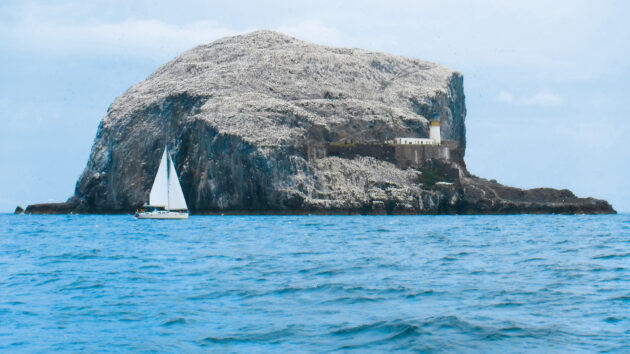
Bass Rock was a swirl of gannets as they passed. Photo: Peter Russell
The pontoon was jointly run by the Royal Forth YC and the Forth Corinthian YC and there was a notice board at the top of the ramp with access codes for pontoon and showers and payment instructions. The joy of being in Granton is the close and easy access right into Princes Street in the heart of Edinburgh, or to the Royal Yacht Britannia in nearby Leith Docks.
Buses are only a short walk from the pontoon. While the easterlies blew through, we made the most of the next few days and saw as much as we could. It always feels amazing to arrive on our own boat at one of the world’s great historic cities and this was no exception.
Edinburgh is not alongside the water in quite the same way as London or Paris, Copenhagen or Lisbon, but nonetheless there are many highpoints in the city from where it is clear just how connected the city is to its coastline.
Northwesterly 3 to 5, becoming variable at times. Slight or moderate. Showers, perhaps thundery. Good, occasionally poor.
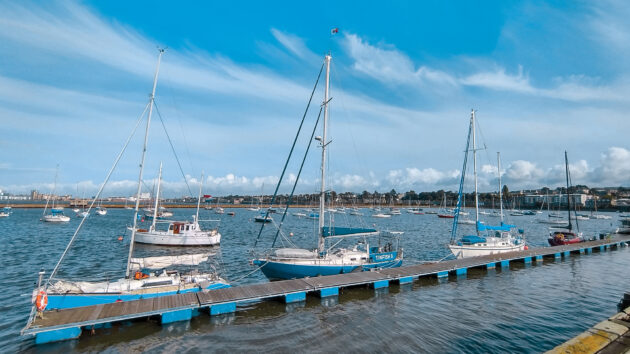
The visitor pontoon at Granton is a perfect location for exploring Edinburgh. Photo: Peter Russell
Final Stop: Berwick-upon-Tweed
Moderate northwesterly winds were exactly what we needed to carry on homewards. Clear of Granton, we set the twin headsails and carried them all the way out of the Firth, the wind bending round behind us so that we carried them onwards still, inside the Bass Rock, swirling with gannets, past Dunbar and just past St Abb’s Head, where the wind eventually dropped out.
We called Eyemouth but they were doing some dredging work in the Gunsgreen basin and all the fishing boats were in the mix with visitors, so there was no room at the inn for Tinfish. We hadn’t really planned on going into Berwick, but timings worked for going in on the second half of the flood.
With the light offshore wind and flat seas, we decided to be brave. After six weeks round the coast of Scotland we would be returning to England. The pilotage guidance for Berwick talks about the bar and shifting channels and had been enough to make us feel rather doubtful.
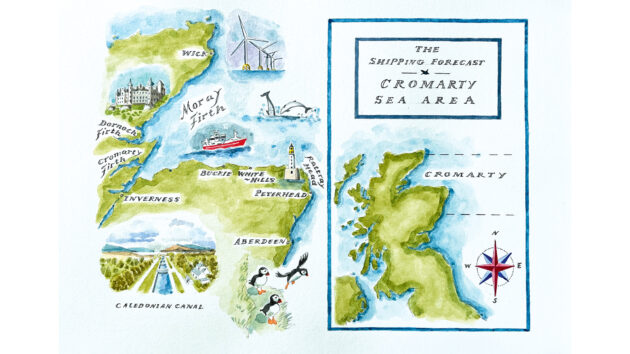
We reminded ourselves that coasters still go in and out of the port. In the conditions we had, however, it couldn’t have been more straightforward. We crossed the bar two-and-a-half hours before high water and had plenty of depth all the way in.
The visitor pontoon is immediately to port inside the Tweed Dock. It’s a completely protected spot but at the end of a working basin which can, temporarily, become quite filthy with pine flakes washed off from the timber cargoes. Even so it seems to be a favourite place for swans which gather there in big numbers. Like the swans, we were, once again, made to feel very welcome.
Old Berwick-upon-Tweed, a short walk from the dock across the old bridge, is contained within elizabethan ramparts and well-preserved town walls that are testament to its part in many centuries of border battles. A walk around the walls was a good way for us to get acquainted with the town and to understand its age-old strategic importance. It is a harbour but also a river crossing, a fortress but also a market town. For us, it was significant as our first port back in England but our last in the Forth sea area. From here we were heading into Tyne and the first stop would be Holy Island.
Enjoyed reading this?
A subscription to Yachting Monthly magazine costs around 40% less than the cover price, so you can save money compared to buying single issues.
Print and digital editions are available through Magazines Direct – where you can also find the latest deals.
YM is packed with information to help you get the most from your time on the water.
-
-
- Take your seamanship to the next level with tips, advice and skills from our experts
- Impartial in-depth reviews of the latest yachts and equipment
- Cruising guides to help you reach those dream destinations
-
Follow us on Facebook, Twitter and Instagram.
Note: We may earn a commission when you buy through links on our site, at no extra cost to you. This doesn’t affect our editorial independence.

